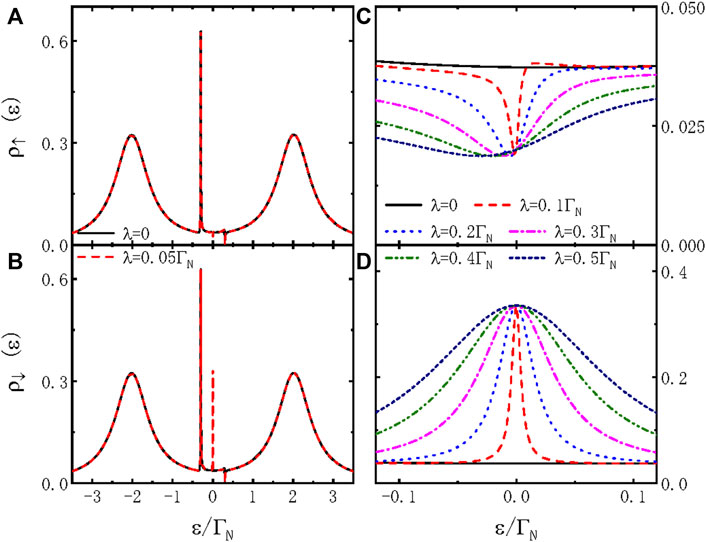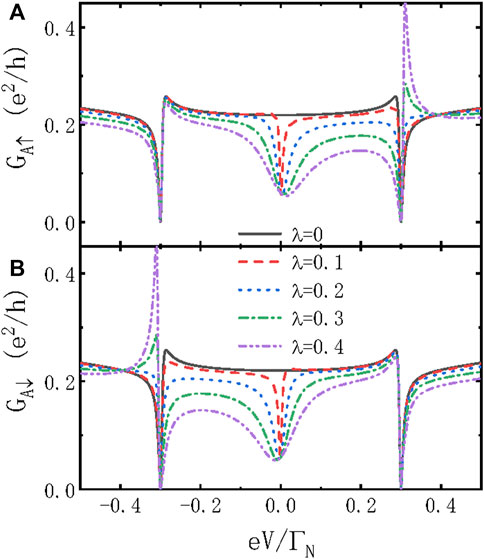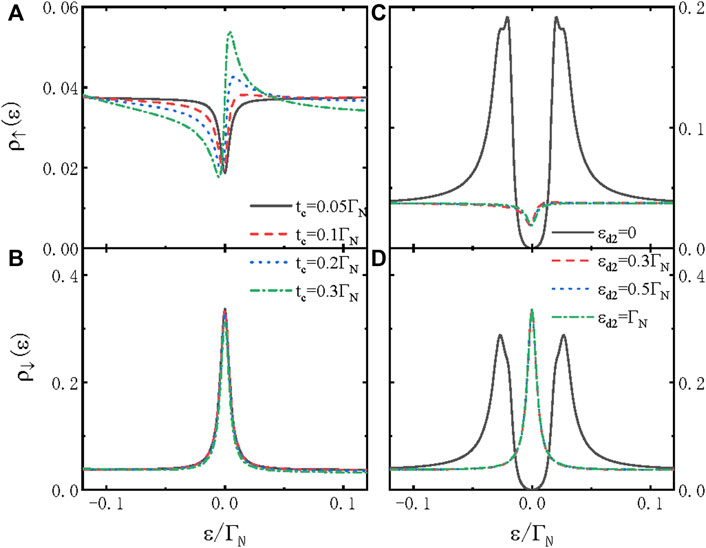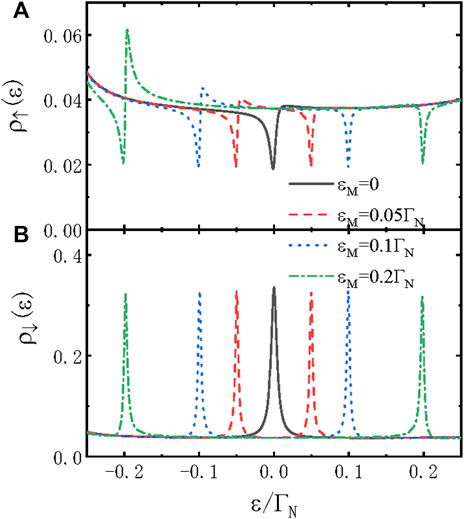- 1College of Science, North China University of Technology, Beijing, China
- 2School of Science, Inner Mongolia University of Science and Technology, Baotou, China
We theoretically study the Andreev reflection processes in T-shaped double quantum dots (TDQDs) in terms of the nonequilibrium Green’s function technique. It is considered that one of the TDQDs is coupled to the Majorana zero modes (MZMs) prepared at the ends of a topological superconductor nanowire and simultaneously to one metallic and one superconductor lead. Our numerical results show that the in-gap state originated from the proximity effect due to the superconductor lead being sensitive to the existence of MZMs. The local density of states (LDOS) of the spin-up electrons, which are directly coupled to the MZMs, has a Fano antiresonance at the in-gap state. Meanwhile, the local density of the spin-down electrons, which are free from hybridization to the MZMs due to the helical property of the latter, has a Lorentzian resonance at the same state. The differential Andreev conductance of both the spin directions exhibits Fano-type resonance but with different tails’ directions. The in-gap state is also significantly influenced by the energy level and coupling strength of the other side-coupled dot, as well as the MZM–MZM interaction.
1 Introduction
Recent developments in nano-fabrication techniques have enabled the implementation of hybrid devices composed of different materials, such as semiconductor quantum dots (QDs) and metallic or superconductor leads [1–5]. The most important aspect of interest in such a system is the construction of quantum bits relying on the Andreev bound states [6, 7], which are superpositions of the QDs’ energy levels and Bogoliubov states in the superconductor leads. In some earlier work, systems with one or multiple QDs connected to one metallic and one superconductor lead were intensively studied, taking the electron–electron interaction that is responsible for the Coulomb blockade and Kondo effects into consideration [3, 8–10]. In macroscopic structures, it is known that the Coulomb interaction between electrons will suppress local pairing and then enhance intersite superconductivity through mechanisms such as spin-exchange processes. However, the relationship between the Coulomb interaction and local pairing is quite difficult to be uncovered, either theoretically or experimentally. Fortunately, this limitation can be overcome in nanoscale structures by varying the isolated energy levels or interaction strength between electrons. These will change the charge transport and result in a controllable adjustment of the Kondo effect and the opposite case determined by the electron pairing on the QDs. There was also some work concerning joint influences of the quantum interference and proximity effect on electronic transport in multiple QDs, such as T-shaped double quantum dots (TDQDs) sandwiched between one conducting and one superconducting lead [9, 11–13]. It was found that in the subgap regime, i.e., when the external bias voltage is smaller than the energy gap of the superconductor lead [9, 10], the electron transfer is determined by the anomalous Andreev reflections when an electron entering into the dot from the metallic lead is converted into the Cooper pair accompanied by the simultaneous reflection of a hole back to the metallic lead. The transmittance of this Andreev reflection is promising in detecting on-dot pairing induced by the proximity effect and the quantum interference, as well as the Coulomb blockade or Kondo effects. In the presence of on-dot pairing due to the superconductor lead, the quantum interference processes are doubled as compared to similar structures without the superconductor lead. In particular, for TDQD systems, the side-coupled QD induces resonance or antiresonance at particular dot levels controllable by the gate voltage. As a result of it, the Fano effect emerges on the condition that the coupling strength between the two dots is much weaker than that between the dot and the metallic lead [9]. With increasing inter-dot coupling strength, the Fano-type resonance disappears and finally evolves into the Lorentzian resonance due to spreading out of the on-dot pairing from the central dot to the side-coupled dot.
Recent theoretical and experimental works have proved that Majorana zero modes (MZMs) may emerge as exotic quasiparticles at opposite ends of one-dimensional topological superconductors. The MZMs were first predicted in the Kitaev chain of the p-wave superconductor as the degenerate ground state obeying non-Abelian statistics [14, 15]. They are protected by the topological gap and are robust against local perturbations, which makes them promising in fault-tolerant quantum computation [15–17]. Since the spinless Kitaev chain and p-wave superconductor are rare in nature, various theoretical and experimental schemes were then subsequently proposed, such as the hybridized one-dimensional semiconductor–superconductor nanowire under a large enough magnetic field, which is usually called a Majorana nanowire [2, 18]. A p-wave superconductor is realized from the s-wave superconductor due to the proximity effect, given that the semiconductor nanowire has a strong Rashba-type spin-orbit coupling. Unlike the MZMs in the Kitaev chain, others prepared at the ends of the Majorana wire are spinful and may interact with electrons of both the spin directions. To detect the MZMs invasively, researchers also proposed to couple the MZMs to QDs sandwiched between metallic leads [18, 19]. Some interesting phenomena were then found, such as half of the quantum value of the electron conductance [19] and sign reversion of the thermopower [20–22]. There were also some works concerning MZMs hybridized to QDs with metallic and superconductor leads [23–25]. It was found that in the absence of the intradot Coulomb interaction, there is destructive (constructive) interference for spin-up (spin-down) electrons at the in-gap states. Such an interference effect, combined with the MZMs, exerts significant influence on the transport processes and can be inferred from the local density of states (LDOS) of the QDs and the in-gap Andreev conductance.
In the present article, we study transport through TDQDs side-coupled to the Majorana nanowire having one metallic and one superconductor lead. We concentrate on the influences of the MZMs on the LDOS and Andreev differential conductance within the in-gap regime. Our numerical results show that the LDOS of the spin-up electrons which are directly coupled to the MZMs have an asymmetrical Fano line shape. However, the spin-down electrons that are not directly hybridized to the MZMs have a Lorentzian line shape at the same state. Both spin-up and spin-down differential Andreev conductances have Fano-type resonance at the in-gap state but with different directions of the tails in the line shape. The direct hybridization between the MZMs and side-coupled dots will significantly change the Fano effect.
2 Model and methods
The system is composed of TDQDs connected to one metallic and one superconductor lead, and a nanowire hosting MZMs can be modeled by the following Hamiltonian[9, 10, 19]:
in which the Hamiltonian for the TDQDs in the absence of the intradot Coulomb interaction is
where ΓS = ∑k|VkS|2δ(ɛ − ɛkS) denotes the line-width function of the central dot and the superconductor lead with VkS the electron’s tunneling amplitude contained in the Hamiltonian for tunneling between the central dot and the leads
in which δM is the interaction strength between the MZMs with operators satisfying
where Green’s function of electrons on the TDQDs free from the interaction between the leads and the MZMs is given by
3 Results and discussion
In this section, we present numerical results by choosing the coupling strength between the central dot and the metallic lead ΓN ≡ 1 as an energy unit with fixed ΓS = 4ΓN. Such a choice of the line-width functions enables the transport processes through the system to be dominated by on-dot pairing arising from the interaction between the dot and the superconductor lead [9, 10]. Otherwise, for ΓS ≪ΓN, the electronic states are determined by the Kondo effect arising from the Coulomb repulsion between the spin-up and spin-down electrons, which is neglected in the present paper. Figure 1 presents the spin-dependent LDOS as a function of electron energy ɛ for different values of dot-MZM coupling strength λ. For λ = 0, the spin-up LDOS in Figure 1A shows the typical four-peak structure. The peaks formed at the effective quasiparticle states

FIGURE 1. (Color online) Spin-dependent LDOS ρσ varying with respect to the electron energy ɛ for different values of dot-MZM hybridization strength λ. The tunneling strength between the central dot and the side-coupled dot is fixed as tc = 0.2ΓN. The energy levels of the two dots are ɛd1 = 0 and ɛd2 = 0.3ΓN, respectively. Direct hybridization between the MZMs is ɛM = 0.
Turning on the coupling between the spin-up electrons on the central dot and one mode of the MZMs formed at the ends of the nanowire (λ ≠ 0), a dip (peak) emerges in the spin-up (spin-down) LDOS when the electrons’ energy ɛ is aligned to the Fermi energy in the normal metallic lead μ = 0 (see the red lines in Figures 1A,B). Such a result is the consequence of the combined effect of MZMs and the on-dot pairing due to the superconductor lead. There are two new features in the present TDQDs with one metallic and one superconductor lead as compared to the case of the TDQDs coupled to two normal metallic leads. First, the zero-energy LDOS develops a dip other than a peak that occurred in the latter case. This is due to the combined effects of the quantum interference from the side-coupled dot and on-dot pairing from the superconductor lead. Second, if the spin-down electrons are decoupled from the MZMs, a resonant peak emerges at ɛ = 0 for nonzero λ. The interaction between the spin-up and spin-down electrons can be understood by examining the off-diagonal elements of the self-energy. If the central dot is coupled to both metallic leads, the spin-down electrons will not be influenced by the MZMs, and the LDOS is solely determined by the quantum interference effect due to the side-coupled dot. The present result is interesting for both detecting the existence of the MZMs and distinguishing electrons of the different spin components, provided there is hybridization between the central dot and the MZMs. As was mentioned previously, searching for the detection scheme for the MZMs is still an important issue in current condensed matter physics. The phenomenon found here may provide a new feasible way for the aforementioned task. With increasing λ, the widths of the dip (peak) in spin-up (spin-down) LDOS become wider with a fixed value of ρ↑(↓)(ɛ = 0). Meanwhile, the spin-up and spin-down LDOS remain in the asymmetrical Fano-type and Lorentzian line shape, respectively.
Combined functions of the MZMs, quantum interference, and proximity effect can also be studied by measuring the tunneling current through the system. In Figure 2 we show the dependence of the differential Andreev conductance GAσ(V) = dIAσ/dV at zero temperature on the bias voltage V. Only a relative narrow bias regime covering the in-gap quasiparticle peak is presented. The quasiparticle peaks at

FIGURE 2. (Color online) Spin-resolved Andreev differential conductance GAσ as a function of the bias voltage eV for the same parameters adopted in Figure 1.
In Figure 3, we present the impacts of the interdot coupling tc and dot level ɛd2 on the LDOS. Figure 3A shows that the spin-up LDOS has a Lorentzian-type dip when the electron energy ɛ is aligned to the dot level ɛd1 = 0 for a small value of tc = 0.05ΓN (the solid line). The spin-down LDOS in Figure 3B, however, has a Lorentzian-type peak at ɛ = 0. With increasing tc, the quantum interference effect brought about by the additional dot is strengthened, and thus, the spin-up LDOS in Figure 3A shows the Fano line shape. The spin-down LDOS remains in the Lorentzian line shape with a lower peak height. Figures 3C,D show that the LDOS of both the spin-up and spin-down electrons has a symmetrical double-peak configuration, with ρσ(0) ≡ 0 for ɛd2 = 0. For non-zero ɛd2, a Fano (Lorentzian)-type resonance emerges in the zero-energy spin-up (spin-down) LDOS due to the quantum interference effect. These results are consistent with those in Figures 3A,B. It should be noted that the MZMs are quasiparticles of Majorana fermions, which are characterized by the zero-energy property. Therefore, the MZMs will induce a sharp peak in the spectral function located at the zero-energy level or the zero-bias peak in electrical conductance, which are the most reliable signatures of the existence of MZMs for far. Apart from the zero-energy state, there are no distinct peaks or valleys in spectral function, and then, these states are relatively less important as compared to the zero-energy state. In the presence of the Coulomb repulsive interaction between electrons on the QD, there are two energy states without the external magnetic field. One is at the Fermi level (which is usually at zero-energy), and the other is aligned to the Fermi energy plus the strength Coulomb interaction. As was discussed previously, the state concerning the Coulomb interaction is less influenced by the MZMs, and then, we neglect the Coulomb interaction in the QDs.

FIGURE 3. (Color online) Spin-dependent LDOS as a function of the electron energy ɛ for different values of tc in (A) and (B), and different
The two modes of the MZMs will interact with each other with a strength of δM, which depends on the length of the nanowire hosting the MZMs. The MZM–MZM hybridization δM exerts significant influences on the electronic transport properties [19–21, 28–30]. For example, the half-fermionic nature of the MZMs (the zero-energy linear conductance of the QD side-coupled to the MZMs is half of its quantum value G (eV = 0) = e2/2h) is destroyed by δM [19]. It can also induce a sign reversion in the thermopower of the QD side-coupled to the MZMs [20, 21]. Figure 4 shows that the MZM–MZM hybridization split the single Fano (Lorentzian) resonance in spin-up (spin-down) LDOS for the case of δM = 0 into double Fano (Lorentzian) resonance configuration, which is centered at ɛ = ±δM. This result is qualitatively consistent with that in [19]. The main difference in the LDOS between the present system and that of [19] is the disappearance of the central peak due to the presence of the superconductor lead. With increasing δM, the Fano peaks in the spin-up LDOS become more asymmetric in the negative energy regime, but that in the positive energy regime evolves into a Lorentzian one. For the spin-down electrons, their LDOS is less changed by the variation of δM. This is because the spin-down electrons are not directly coupled to the MZMs in the present structure. At last, we note that in experiments, the two modes may interact with the QD simultaneously. [19] Usually, the coupling of the QD to both the modes will enhance or suppress the impacts of the MZMs depending on the arrangement of the coupling strength of different modes. Such a case generally will not change the qualitative functions of the MZMs on the LDOS or the Andreev differential conductance. Another impact of the coupling between the dots with the two modes of the MZMs is the introduction of a phase factor arising from the closed geometry. This phase factor will also exert important influences on the quantum interference effect and is worth discussing in the future.

FIGURE 4. (Color online) Spin-dependent LDOS changing with the electron energy for different values of the direct overlap between the MZMs ɛM. Other parameters are as in Figure 1.
4 Summary
In summary, we have studied electronic transport through T-shaped DQDs with the central dot coupled to one normal metallic and one superconductor lead, as well as to a nanowire hosting MZMs. Our numerical results show that the combined effects of the QD–MZM interaction and the on-dot pairing from the superconductor lead exert significant impacts on the LDOS and the Andreev differential conductance. Under some conditions, a Fano- or Lorentzian-type resonance emerges in the spin-resolved LDOS or conductance, which depends on whether the electrons are coupled to the MZMs. Either the position or the strength of the resonance can be efficiently tuned by the quantities related to the MZMs, such as QD-MZMs or MZM–MZM hybridization strengths. The quantum interference arising from the side-coupled dot will change the molecular states induced by the MZMs and the superconductor lead, thus providing an effective means to adjust the system’s transport properties.
Data availability statement
The original contributions presented in the study are included in the article/Supplementary Material; further inquiries can be directed to the corresponding author.
Author contributions
L-LS derived the formulae, performed the numerical calculations, and wrote the original manuscript. JL helped derive the formulae and explain the physical mechanisms of the results.
Funding
The authors gratefully acknowledge the financial support from the R&D Program of Beijing Municipal Education Commission (KM201910009002) and the NSFC (Grant No. 12264037).
Conflict of interest
The authors declare that the research was conducted in the absence of any commercial or financial relationships that could be construed as a potential conflict of interest.
Publisher’s note
All claims expressed in this article are solely those of the authors and do not necessarily represent those of their affiliated organizations, or those of the publisher, the editors, and the reviewers. Any product that may be evaluated in this article, or claim that may be made by its manufacturer, is not guaranteed or endorsed by the publisher.
References
1. Deacon RS, Tanaka Y, Oiwa A, Sakano R, Yoshida K, Shibata K, et al. Tunneling spectroscopy of andreev energy levels in a quantum dot coupled to a superconductor. Phys Rev Lett (2010) 104:076805. doi:10.1103/PhysRevLett.104.076805
2. Mourik V, Zuos K, Frolovs M, Plissarde R, Bakkers PAM, Kouwenhoven LP. Signatures of majorana fermions in hybrid superconductor-semiconductor nanowire devices. Science (2012) 336:1003–7. doi:10.1126/science.1222360
3. Weymann I, Wojcik KP. Andreev transport in a correlated ferromagnet-quantum-dot-superconductor device. Phys Rev B (2015) 92:245307. doi:10.1103/PhysRevB.92.245307
4. Sun QF, Guo H, Wang J. Hamiltonian approach to the ac josephson effect in superconducting-normal hybrid systems. Phys Rev B (2002) 65:075315. doi:10.1103/PhysRevB.65.075315
5. Sun QF, Wang J, Lin TH. Photon-assisted andreev tunneling through a mesoscopic hybrid system. Phys Rev B (1999) 59:13126–38. doi:10.1103/PhysRevB.59.13126
6. Rodero AM, Yeyati AL. Josephson and andreev transport through quantum dots. Adv Phys X (2011) 60:899–958. doi:10.1080/00018732.2011.624266
7. Larsen TW, Petersson KD, Kuemmeth F, Jespersen TS, Krogstrup P, Nygard J, et al. Semiconductor-nanowire-based superconducting qubit. Phys Rev Lett (2015) 115:127001. doi:10.1103/PhysRevLett.115.127001
8. Sun QF, Guo H, Lin TH. Excess kondo resonance in a quantum dot device with normal and superconducting leads: The physics of andreev-normal co-tunneling. Phys Rev Lett (2001) 87:176601. doi:10.1103/PhysRevLett.87.176601
9. Baranski J, Domanski T. Fano-type interference in quantum dots coupled between metallic and superconducting leads. Phys Rev B (2011) 84:195424. doi:10.1103/PhysRevB.84.195424
10. Baranski J, Domanski T. In-gap states of a quantum dot coupled between a normal and a superconducting lead. J Phys : Condens Matter (2013) 25:435305. doi:10.1088/0953-8984/25/43/435305
11. Baranski J, Domanski T. Decoherence effect on fano line shapes in double quantum dots coupled between normal and superconducting leads. Phys Rev B (2012) 85:205451. doi:10.1103/PhysRevB.85.205451
12. Calle AM, Pacheco M, Martins GB, Apel VM, Lara GA, Orellana PA. Fano–Andreev effect in a T-shape double quantum dot in the Kondo regime. J Phys : Condens Matter (2017) 29:135301. doi:10.1088/1361-648X/aa58c1
13. Li YX, Choi HY, Lee HW, Liu JJ. Andreev reflection with spin-flip scattering through a t-shaped double quantum dot. J Appl Phys (2007) 101:103918. doi:10.1063/1.2724832
14. Fu L, Kane CL. Superconducting proximity effect and majorana fermions at the surface of a topological insulator. Phys Rev Lett (2008) 100:096407. doi:10.1103/PhysRevLett.100.096407
15. Nayak C, Simon SH, Stern A, Freedman M, Das Sarma S. Non-abelian anyons and topological quantum computation. Rev Mod Phys (2008) 80:1083–159. doi:10.1103/RevModPhys.80.1083
16. Alicea J, Oreg Y, Refael G, von Oppen F, Fisher MPA. Non-abelian statistics and topological quantum information processing in 1d wire networks. Nat Phys (2011) 7:412–7. doi:10.1038/nphys1915
17. Karzig T, Knapp C, Lutchyn RM, Bonderson P, Hastings MB, Nayak C, et al. Scalable designs for quasiparticle-poisoning-protected topological quantum computation with majorana zero modes. Phys Rev B (2017) 95:235305. doi:10.1103/PhysRevB.95.235305
18. Ricco LS, de Souza M, Figueira MS, Shelykh IA, Seridonio AC. Spin-dependent zero-bias peak in a hybrid nanowire-quantum dot system: Distinguishing isolated majorana fermions from andreev bound states. Phys Rev B (2019) 99:155159. doi:10.1103/PhysRevB.99.155159
19. Liu DE, Baranger HU. Detecting a majorana-fermion zero mode using a quantum dot. Phys Rev B (2011) 84:201308. doi:10.1103/PhysRevB.84.201308
20. López R, Lee M, Serra L, Lim J. Thermoelectrical detection of majorana states. Phys Rev B 89 (2014) 205418. doi:10.1103/PhysRevB.89.205418
21. Hong L, Chi F, Fu ZG, Hou YF, Wang Z, Li KM, et al. Large enhancement of thermoelectric effect by majorana bound states coupled to a quantum dot. J Appl Phys 127 (2020) 124302. doi:10.1063/1.5125971
22. Chi F, Fu ZG, Liu J, Li K, Wang Z, Zhang P. Thermoelectric effect in a correlated quantum dot side-coupled to majorana bound states. Nanoscale Res Lett 15 (2020) 79. doi:10.1186/s11671-020-03307-y
23. Majek P, Gorski G, Domanski T, Weymann I. Hallmarks of majorana mode leaking into a hybrid double quantum dot. arXiv:2202.09227v1 (2022). doi:10.48550/arXiv.2202.09227
24. Feng GH, Zhang HH. Probing robust majorana signatures by crossed andreev reflection with a quantum dot. Phys Rev B (2022) 105:035148. doi:10.1103/PhysRevB.105.035148
25. Zhang P, Wu H, Chen J, Khan SA, Krogstrup P, Pekker D, et al. Signatures of andreev blockade in a double quantum dot coupled to a superconductor. Phys Rev Lett (2022) 128:046801. doi:10.1103/PhysRevLett.128.046801
26. Chi F, Wang J, He TY, Fu ZG, Zhang P, Zhang XW, et al. Quantum interference effects in quantum dot molecular with majorana bound states. Front Phys 8 (2021) 631031. doi:10.3389/fphy.2020.631031
27. Zitko R. Fano-kondo effect in side-coupled double quantum dots at finite temperatures and the importance of two-stage kondo screening. Phys Rev B (2010) 81:115316. doi:10.1103/PhysRevB.81.115316
28. Jiang C, Zheng YS. Fano effect in the andreev reflection of the aharonov–bohm–fano ring with majorana bound states. Solid State Commun (2015) 212:14–8. doi:10.1016/j.ssc.2015.04.001
29. Zeng QB, Chen S, Lü R. Fano effect in an ab interferometer with a quantum dot side-coupled to a single majorana bound state. Phys Lett A (2016) 380:951–7. doi:10.1016/j.physleta.2015.12.026
Keywords: in-gap states, Majorana zero modes, Andreev differential conductance, double quantum dot, Fano effect
Citation: Sun L-L and Liu J (2022) Andreev reflection mediated by Majorana zero modes in T-shaped double quantum dots. Front. Phys. 10:1046802. doi: 10.3389/fphy.2022.1046802
Received: 17 September 2022; Accepted: 28 October 2022;
Published: 14 November 2022.
Edited by:
Qiang Xu, Nanyang Technological University, SingaporeCopyright © 2022 Sun and Liu. This is an open-access article distributed under the terms of the Creative Commons Attribution License (CC BY). The use, distribution or reproduction in other forums is permitted, provided the original author(s) and the copyright owner(s) are credited and that the original publication in this journal is cited, in accordance with accepted academic practice. No use, distribution or reproduction is permitted which does not comply with these terms.
*Correspondence: Lian-Liang Sun, YmFsYWNAMTI2LmNvbQ==
 Lian-Liang Sun
Lian-Liang Sun Jia Liu
Jia Liu